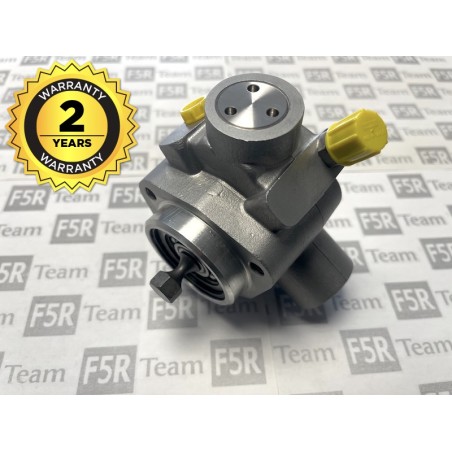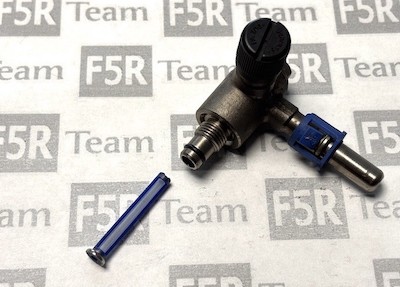- Out of Stock





New high pressure F5R UE116150 fuel pump for Opel / Vauxhall 2.2 Direct. This is an alternative solution to the original Siemens-Continental diaphragm pump GM 24465785, GM 93174538.
This set includes:
1. F5R fuel pump
2. Steel fuel line connector
3. Mounting bolts
Weight 1,2kg
Assembly is very simple, taking around 15 minutes and only requires basic tools. All needed parts are included in the set. As part of assembly, unscrew the original fuel input connector from the GM pump and attach to the F5R pump. In addition keep the original black plastic spacer located between the pump and cylinder head for the new F5R pump assembly.
Biofuels
This is a piston pump so Opel statement does not apply any more "E10 fuel can be used in all petrol-engine Vauxhall vehicles except models with the 2.2-litre direct-injection petrol engine (code Z22YH) used in Vectra, Signum and Zafira.” The issue of the impact of E5 and E10 fuels on aluminum parts of the injection system, such as the injector rail and the high-pressure pump, is discussed here.
Safety note
for the safety reasons, the pump requires a fuel pressure regulator manufactured after 246 09, a reconditioned regulator or a new one. The assembly of regulators manufactured before this date is forbidden. The year of production is the last two digits in the third row on the regulator housing (246 09 > 246 day of 2009). We suggest to install regulators manufactured in 2011 or newer.
Technical note
To diagnose the fuel system, a multimeter with a Hz/% function can measure the PWM signal of the fuel pressure regulator, which is the most important parameter of the pressure regulation system. This parameter is not available from any diagnostic device.
The optimal range of operation for the PWM signal is between 15-45% however the lower the value of signal the easier it maintains correct pressure. At engine idle the signal should between be 15-25% depending on the temperature of the engine as well as the type/condition of the regulator. If the PWM signal at idle is outside normal operating range, the fuel pressure regulator or sensor most likely needs to be replaced.
At full engine load the PWM signal should be within 30-40%. If the PWM signal if over 50% for a 3 seconds there will be a P1191 Fuel Pressure System Malfunction fault. If under load the PWM signal is erroneous then most likely the fuel pump needs to be replaced.
Installed pump
Fuel pressure
PWM of the pressure regulator reading
- does the F5R pump fit the Direct engine? YES, the pumps are manufactured for the Z22YH engine so they fit
- does the pump have a warranty? YES, pumps have 2 years warranty regardless of mileage. Each pump has a serial number so we know when it was sold and the warranty period is counted from that date. You do not need to store any purchase documents
- can I install the pump myself? YES, it's simple and requires some basic keys
- is it necessary to replace the regulator? NO, it is described exactly at the bottom of the page with pressure regulators
- is the pump diaphragm or piston? F5R pumps are piston pumps, the pressing elements are three steel pistons
- are piston pumps better than diaphragm pumps? it cannot be clearly stated, both have their pros and cons. Diaphragm pumps are hydraulic pumps so as long as there is oil in the pump, they practically do not wear out and are therefore mechanically very durable. The disadvantage is that high pressures of 100 bar can damage membranes. Piston pumps are mechanical pumps, parts work in petrol without lubrication and only use the phenomenon of liquid friction, in addition, the guides are covered with a DLC coating that reduces friction and extends the service life. Despite this, the pumps are slowly wearing out. The advantage is the resistance to pressure, They withstand about 300 bar so the maximum working pressure of 110 bar is a piece of cake
- are piston pumps trouble-free? NO, there is nothing faultless, even a hammer can be broken, let alone such a complicated element as a pump. There are only more or less trouble-free things and the piston pump belongs to those less trouble-free
- what is the life of the pump? this is not yet known, pumps should be able to withstand mileage of 200,000 km, but none of the pumps manufactured have such a course yet. One of the first examples has now traveled about 50 thousand km and is comparable to the new pump
- what can break in the pump? practically nothing, because the elements are made of the best materials available. In principle, the pump can only become clogged due to impurities from the fuel. The discharge valve gap is 0.05mm and anything of this diameter can block the valve, the pump will stop working
- what to do if the pump is damaged in the route? in the case of deep emergency mode (complete lack of power), turn off the engine, wait about 30 seconds and remove the plug from the pressure regulator. After starting the engine, you can drive without major problems to about 3000 rpm
🔥Any work on the injection system can only be carried out on a cold engine 🔥
The pump requires a pressure regulator newer than 246 09 (day and year of production). The production date is on the regulator housing, these are the last two numbers in the third row, e.g. 11 is 2011. In refurbished or new F5R regulators, it is not necessary to check the production date. Installing the pump in a system with an older regulator is solely the user's responsibility and any damage to the pump is not covered by the warranty.
After removing the old pump, place the black plastic washer on the new pump. Unscrew the inlet stub from the old pump, check the condition of the filter and screw it to the new pump. (there is a new O-ring in the cap for the connector in case the old one is in bad condition). Check the condition of the filter in the connector. It is recommended to disconnect the fuel line from the connector because it is easier to screw the connector to the pump. After lubrication, the connector is screwed in with your fingers and only tightened with a wrench. Position the hexagonal drive of the pump so that it can be inserted into the head up to the plastic washer. Then screw the pump to the head (10Nm) and the steel cable between the strip and the pump (25Nm)(sometimes it is necessary to bend the cable slightly to fit the pump).
If the fuel rail is empty, first fill the rail with fuel. Loosen the steel cable on the pump connector and turn the ignition on several times. The fuel rail will then be flooded with petrol and air will be pushed out of it.
If the regulator requires reassembly, lubricate the O-rings and seat with grease (10Nm) before installation.
Do not start the engine when the fuel rail is empty.
Start the engine and check for leaks. If not, drive at least 50-100 km to bleed air and adapt the injection system. It is advisable to achieve a temporary speed of 4000-5000 rpm for faster venting. If a fault occurs while driving, restart the engine and continue driving. After cooling down and restarting, the fault may also appear. There is a normal process of venting the injection system.
During the first 1000 km, do not speed up the engine above 3500 rpm for a long time due to the wear of the shaft slide bearings and section slides. For the next 1000 km to 5000 rpm. Failure to do so may result in overheating of the slides and damage to the pump.
Do not turn the engine to cut-off without load
Do not run the engine with the pressure regulator disconnected (this is only allowed in the event of an emergency, e.g. after pump damage). The pump must always work with load and starting the engine with the regulator disconnected may result in the pump requiring service to unblock the delivery valves.
If an injection system error occurs in the initial period of operation, it is advisable to accelerate it several times in second gear to 5000 rpm.
* In accordance with the service manual, after dismantling the pump or regulator, all openings in both the strip and the pump should be plugged. The injection system must not be left open.
* In the case of the Zafira model, check whether the factory fuel filter is installed, if not, it must be installed in the fuel line.
Pump maintenance comes down to periodically checking the fuel filter.
Every 30,000 kilometers, remove the intake manifold and check the filter.

From pump number P4040, you should also unscrew the outlet connector and check the condition of the magnet.
(This element prevents contamination of the pressure regulator).
From pump number P4100, you should also check the condition of the filter.

You might also like